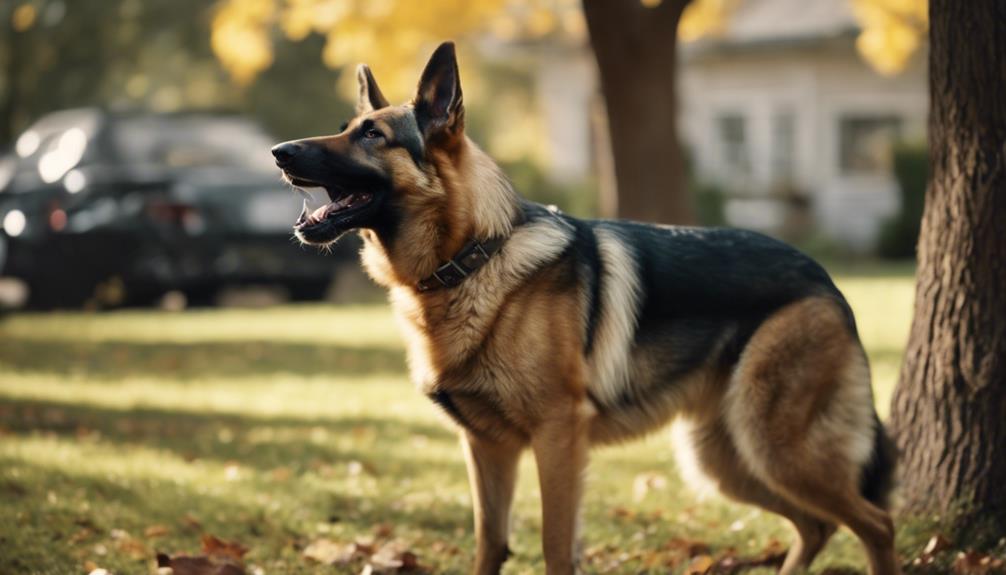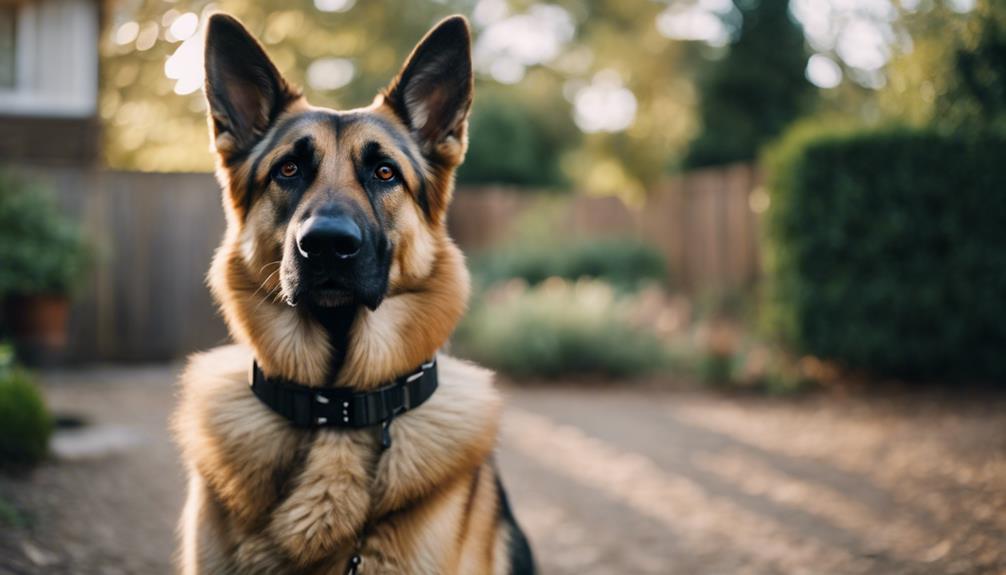🐾 Paw-some Partnership Alert! 🐾
As a pack of German Shepherd enthusiasts at MixGermanShepherd.com, we're always sniffing out the best products for our furry friends. Guess what? When you fetch something from Amazon through our links, we earn a little treat! 🦴
If you've ever wondered about effective ways to manage barking in your German Shepherd mix, there are strategies and tools available that can assist you in this endeavor. Excessive barking can be a common challenge with these intelligent and vocal dogs, but there are methods to address this behavior. By exploring bark control devices tailored to your German Shepherd mix's needs, you can find solutions that help curb unwarranted barking and create a more harmonious environment for you and your furry friend.
Key Takeaways
- Excessive barking in German Shepherd mixes can be managed through positive reinforcement training.
- Effective bark control devices should be selected based on breed needs and safety features.
- Training techniques like teaching 'quiet' commands and consistency are essential for bark control.
- Socialization plays a crucial role in reducing anxiety-driven barking and fostering well-adjusted behavior.
Understanding Excessive Barking in German Shepherds

Excessive barking in German Shepherds can often be attributed to a combination of innate characteristics and environmental factors. German Shepherds and their mixes are naturally vocal, but factors like boredom, anxiety, territorial instincts, or lack of socialization can exacerbate this behavior. When dealing with excessive barking in German Shepherd mixes, understanding the root cause is vital. Training, mental stimulation, regular exercise, and positive reinforcement techniques play a significant role in managing and reducing excessive barking tendencies in these dogs.
One effective tool in addressing excessive barking is a collar designed for bark control. These collars can help in training your German Shepherd mix to associate barking with an undesirable consequence. However, it's essential to use such collars in conjunction with proper training methods to ensure your dog learns the desired behavior effectively. Seeking guidance from a professional trainer or behaviorist can provide personalized strategies tailored to your German Shepherd mix's specific needs, ultimately helping you effectively manage and modify their excessive barking behavior.
Behavioral Triggers in German Shepherd Mixes

German Shepherd mixes often exhibit behavioral triggers such as barking, digging, or jumping due to their high energy levels and intelligence. These triggers can also be influenced by environmental factors such as lack of exercise, socialization, or mental stimulation. It's crucial to understand that specific mix breed characteristics play a role in identifying triggers like separation anxiety or herding instincts in German Shepherd mixes. Positive reinforcement training methods have been proven effective in addressing and modifying these behavioral triggers. Consistent training, mental enrichment activities, and proper socialization are essential for managing and preventing such triggers in German Shepherd mixes. By providing a structured environment, engaging in mental stimulation activities, and using positive reinforcement techniques, you can help your German Shepherd mix develop appropriate behaviors and responses. Remember, a well-rounded approach that considers both the breed's tendencies and individual needs is key to fostering a well-behaved and balanced canine companion.
Training Techniques for Bark Control

When training your German Shepherd mix for bark control, focus on teaching basic commands for quiet behavior, utilizing positive reinforcement methods to encourage desired responses. Stay consistent in your training efforts, reinforcing good behavior and addressing barking promptly. By establishing clear boundaries and using positive techniques consistently, you can effectively train your German Shepherd mix to control excessive barking.
Basic Commands for Quiet
To effectively train your German Shepherd mix to control their barking behavior, start by teaching them basic commands like 'quiet' or 'enough'. Using positive reinforcement techniques such as treats or praise when your dog responds to the 'quiet' command can be highly effective. Consistency and patience are key elements in training your German Shepherd mix to stop barking on command. Practice the 'quiet' command in various environments and situations to reinforce the training. Remember, seeking professional help is a viable option if your German Shepherd mix continues to exhibit excessive barking despite your training efforts.
- Use treats or praise for positive reinforcement.
- Consistency and patience are crucial.
- Practice 'quiet' command in different settings.
- Consider seeking professional help if needed.
Positive Reinforcement Methods
To effectively train your German Shepherd mix in bark control, employing positive reinforcement methods is crucial for shaping desired behavior patterns and reducing excessive barking tendencies. Positive reinforcement involves rewarding your dog with treats, praise, or toys when they exhibit quiet behavior, reinforcing the idea that staying silent is rewarding. Redirecting your dog's attention, teaching them quiet commands, and encouraging calm behavior are effective training techniques to address excessive barking. Consistency in using positive reinforcement is key to successfully modifying barking behavior in German Shepherd mixes. By focusing on rewarding silence and good behavior rather than punishing barking, you can create a strong bond with your dog while promoting a peaceful environment through these effective bark control techniques.
Consistency in Training
Consistent application of positive reinforcement techniques is essential for effectively training German Shepherd mixes in bark control. To achieve success in managing barking behavior, consider the following:
- Consistency: Ensure you are consistent in your training approach to avoid confusion.
- Positive Reinforcement: Use rewards and praise consistently to encourage desired behaviors.
- Training Exercises: Regular practice of specific training exercises can help reinforce bark control.
- Feedback: Provide clear and immediate feedback to your German Shepherd mix during training sessions.
Positive Reinforcement Methods for Barking

How can positive reinforcement methods effectively address barking behavior in German Shepherd mixes? Positive reinforcement techniques focus on rewarding desired behaviors rather than punishing unwanted barking. By using treats, toys, or praise to reinforce moments of quiet, German Shepherd mixes learn to associate silence with positive outcomes. Consistent and immediate rewards for not barking help shape good behavior in these dogs. Short, frequent, and engaging training sessions are key to keeping your German Shepherd mix motivated and eager to learn.
Through positive reinforcement, not only can you effectively address barking behavior in German Shepherd mixes, but you also strengthen the bond between you and your furry companion. By rewarding behaviors you want to see more of, like staying quiet, you communicate clearly with your dog. This approach helps your German Shepherd mix understand what behaviors lead to positive outcomes, making training more effective and enjoyable for both of you. Remember, silence rewards can be just as powerful as other forms of positive reinforcement in shaping your dog's behavior.
Effective Bark Control Devices

When selecting bark control devices for your German Shepherd mix, prioritize features like adjustable sensitivity levels and multiple training modes for optimal effectiveness. German Shepherds are known for their intelligence and strong will, so choosing a bark control device that can be tailored to their specific needs is crucial. Consider the following when looking for the right bark control solution:
- Adjustable Sensitivity Levels: Ensure the device can be customized to respond accurately to your German Shepherd mix's barking habits.
- Safety Mechanisms: Look for bark collars with built-in safety features to prevent any harm or overstimulation to your furry friend.
- Waterproof Materials: German Shepherds are active dogs that enjoy outdoor activities; a waterproof bark control device will withstand their adventures.
- Professional Consultation: Seek advice from trainers or veterinarians to determine the most suitable bark control device for your German Shepherd mix based on their behavior and temperament.
Choosing the Right Bark Collar

When selecting a bark collar for your German Shepherd mix, it's crucial to consider the collar fit, training modes, and sensitivity adjustment feature. Ensuring the collar fits comfortably and securely on your mix is essential for effective bark control. Look for options with adjustable sensitivity levels to tailor the training to your dog's specific barking behavior.
Collar Fit Importance
Properly fitting the bark collar is crucial to effectively control barking behavior in German Shepherd mixes. To ensure you get the best results from your bark control collar, consider the following:
- Choose the Right Size: Select a collar size based on your dog's neck circumference for accurate sensor placement.
- Snug Fit: A well-fitted collar prevents false triggers and ensures the device responds appropriately to barking.
- Adjustable Straps: Opt for collars with adjustable straps to customize the fit for your German Shepherd mix.
- Optimize Fit: Avoid making the collar too tight or too loose; finding the perfect balance is key for effective bark control.
Training Mode Options
Considering the training mode options available is crucial when selecting the right bark collar for your German Shepherd mix. Look for collars that offer various training modes like sound, vibration, or static correction to find the most effective method for your dog. Opt for bark collars with adjustable sensitivity levels, allowing you to tailor the training experience to suit your German Shepherd mix's needs. Ensure the collar fits comfortably and securely on your dog by considering their size and weight. Prioritize safety features such as automatic shut-off and overstimulation prevention to keep your furry friend safe during training sessions. By choosing a bark collar with the right training modes and safety features, you can effectively train your German Shepherd mix to control their barking behavior.
Sensitivity Adjustment Feature
To ensure effective training outcomes with your German Shepherd mix, selecting a bark collar with a customizable sensitivity adjustment feature is essential. This customization is crucial for matching the barking behavior of German Shepherd mixes. Here are some key points to consider when choosing a bark collar with a sensitivity adjustment feature:
- Tailoring Correction Levels: Adjust the correction level to suit your dog's barking tendencies.
- Preventing Unnecessary Activation: Avoid false triggers by setting the sensitivity level accurately.
- Effective Triggering: Ensure the bark collar is activated only when barking reaches the set sensitivity.
- Individualized Training: Fine-tune the sensitivity to address your German Shepherd mix's unique barking habits effectively.
Choosing the right sensitivity level in bark collars is vital for successful and humane training outcomes with German Shepherd mixes.
Managing Barking With Training Plans

Implementing positive reinforcement training plans can effectively manage barking behavior in German Shepherd mixes. By using consistent commands and rewards, you can teach your German Shepherd mix appropriate barking behaviors. It's essential to provide mental and physical stimulation to prevent boredom, which can lead to excessive barking. If your German Shepherd mix continues to exhibit problematic barking, consider seeking professional training assistance to address specific issues. Creating a structured routine and environment for your German Shepherd mix can help them feel secure and reduce barking triggers. Below is a table that highlights key points for managing barking through training plans:
| Key Points | Description |
|---|---|
| Consistent Commands | Use the same commands consistently to reinforce desired barking behaviors. |
| Rewards | Reward your German Shepherd mix with treats or praise for good behavior. |
| Mental & Physical Stimulation | Engage your dog in activities that stimulate their mind and body. |
Socialization Impact on Barking Behavior

To effectively shape your German Shepherd mix's barking behavior, understanding the impact of socialization is essential. Proper socialization can significantly influence how your dog responds to various stimuli, including barking triggers. Here are some crucial points to consider:
- Reducing Anxiety and Fear-Related Barking: Adequate socialization helps your German Shepherd mix become more confident and less prone to barking out of fear or anxiety.
- Positive Exposure: Introducing your dog to different environments, people, and animals from an early age can positively impact their barking tendencies.
- Preventing Protective Barking: Early socialization can help prevent your mix breed from developing excessive territorial or protective barking behaviors.
- Well-Adjusted Behavior: Positive social interactions can lead to a well-adjusted German Shepherd mix that is less reactive when it comes to barking.
Consistency in Bark Control Strategies

Consistency plays a crucial role in effectively training bark control strategies for German Shepherd mixes. When it comes to mixed-breed dogs like German Shepherds, using consistent commands and methods is essential for reinforcing desired behaviors. Varying approaches or inconsistent training can lead to confusion and hinder progress in bark control training. By establishing a routine and sticking to it, German Shepherd mixes can better understand expectations and respond appropriately to training. Regular practice and reinforcement of training techniques are key to achieving consistent results in bark control for mixed-breed dogs. Remember to be patient and persistent in your training efforts, as consistency is the cornerstone of successful bark control strategies for German Shepherd mixes. By staying consistent in your approach, you can help your furry friend learn to bark less and exhibit more desirable behaviors in various situations.
Frequently Asked Questions
How Do I Stop My German Shepherd From Barking so Much?
To stop your German Shepherd from barking excessively, use positive reinforcement, engage in training methods, provide mental stimulation and exercise, recognize behavioral cues, and consider professional help for tailored solutions. Consistent routines and a calm environment are key.
Do Bark Collars Work for German Shepherds?
Bark collars can be effective for German Shepherds by providing a deterrent to excessive barking behavior. German Shepherds are known for their vocal nature, making bark collars a useful tool for training and behavior management.
Why Do German Shepherds Bark so Much at Night?
To reduce nighttime barking in German Shepherds, focus on training methods that encourage calm behavior, establish consistent sleep schedules, identify and address anxiety triggers, manage environmental factors, understand vocal communication, and analyze behavioral patterns for effective solutions.
Why Is My German Shepherd so Quiet?
If your German Shepherd is unusually quiet, consider various training methods to understand behavioral cues, vocalization patterns, and environmental factors. Engage in bonding activities, ensure sufficient exercise, and monitor for health issues or aging effects.
Conclusion
Congratulations! You now have all the tools to tackle excessive barking in your German Shepherd mix with confidence. Remember, consistent training and positive reinforcement are key to success. Choose the right bark control device that suits your furry friend's needs, and watch as peace and quiet reign in your home. With dedication and patience, you'll be well on your way to a harmonious relationship with your beloved pup. Happy training!
